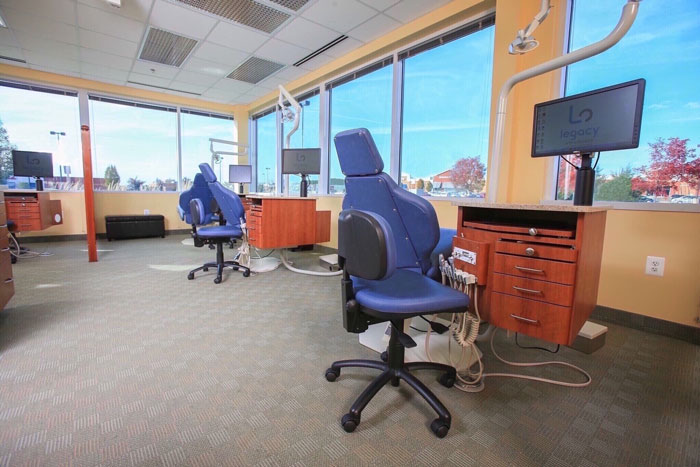The 8-Minute Rule for Legacy Orthodontics
Table of ContentsLegacy Orthodontics Things To Know Before You Get ThisThe smart Trick of Legacy Orthodontics That Nobody is Talking AboutLegacy Orthodontics Fundamentals ExplainedGetting The Legacy Orthodontics To WorkLegacy Orthodontics - Questions
In enhancement, we offer flexible treatment schedules, flexible repayment alternatives and a fun, delightful experience.An orthodontist is a dental expert trained to identify, protect against, and deal with teeth and jaw irregularities. Orthodontists function with individuals of all ages, from youngsters to grownups.
Malocclusion, or misaligned teeth, can cause oral issues, consisting of dental caries, gum tissue disease, and tough or excruciating eating. But not everyone is born with straight teeth. If you have a poor bite or huge spaces between your teeth, you might want to consult a dental professional focusing on orthodontic care.
An Unbiased View of Legacy Orthodontics
( Picture Credit: DigitalVision/Getty Images) Orthodontists use repaired and detachable oral devices, like dental braces, retainers, and bands, to transform the position of teeth in your mouth. Orthodontic therapy is for oral irregularities, including: Crooked teethBite issues, like an overbite or an underbiteCrowded teeth or teeth that are too much apartJaw misalignmentThe goal of orthodontic treatment is to improve your bite.
A healthy and balanced bite ensures you can consume, chew, and talk properly. While you might consider orthodontists as mainly for children or teenagers who need braces, they can deal with oral problems at any kind of age. Orthodontists attend university, oral institution, and orthodontic college. After college graduation, they spend 2 or 3 years in an orthodontic residency program.
All orthodontists are dentists, yet not all dental professionals are orthodontists. Orthodontic residency programs provide intensive, concentrated guideline for dental specialists. They concentrate on two areas: How to effectively and safely move teeth Just how to properly direct advancement in the teeth, jaw, and faceOnce an orthodontist has completed training, they have the choice to come to be board certified.
The Facts About Legacy Orthodontics Revealed
Imbalance, or malocclusion, is one of the most usual reason people see an orthodontist. It is hereditary and is the result of dimension distinctions between the top and reduced jaw or between the jaw and teeth. Malocclusion results in tooth overcrowding, an askew jaw, or irregular bite patterns. Malocclusion is normally treated with: Your orthodontist affixes steel, ceramic, or plastic square bonds to your teeth.
If you have only small malocclusion, you might have the ability to use clear braces, called aligners, rather than traditional braces (http://tupalo.com/en/users/8018300). Some individuals require a headwear to assist move teeth right into line with pressure from outside the mouth. After dental braces or aligners, you'll need to wear a retainer. A retainer is a custom-made tool that maintains your teeth in location.
They're frequently made use of on kids. They can produce added room in the mouth without needing to pull teeth. If you have a serious underbite or overbite, you could need orthognathic surgical treatment (likewise called orthodontic surgical procedure) to lengthen or reduce your jaw. Orthodontists utilize cables, medical screws, or plates to sustain your jaw bone.
You may need to see an orthodontist if you have: Crowding or not sufficient area for every one of your teethOverbite, when your upper teeth come over your base teethUnderbite, when your bottom teeth are as well much forwardSpacing or issues with gapsCrossbite, which is when your top teeth fit behind your base teeth when your mouth is closedOpen bite or a vertical space between your front bottom and upper teethMisplaced midline, when the center of your base and top teeth don't line up Remedying a dental malocclusion can: Make biting, chewing, and speaking easierImprove the balance of our face and your general appearanceEase discomfort from temporomandibular joint disordersSeparate your teeth and make them easier to clean up, helping stop dental caries or tooth cavities It's often a dental practitioner who initially notices misaligned teeth during a routine exam.
The Definitive Guide for Legacy Orthodontics

During your very first orthodontic examination, you'll likely have: A dental examPhotos taken of your face and smileDental X-raysPanoramic (360 level) X-rays of your face and headImpressions to develop molds of your teethThese examinations will help your orthodontist understand how to wage your treatment. leesburg clear braces. An orthodontist is a dental expert who's had training to treat your teeth and jaw
Orthodontists may do surgery, exams,X-rays,and even more to aid you achieve an extra comfy, much healthier smile. An orthodontist is focused on your bite, so something like a damaged tooth would certainly be managed by a dental professional. Orthodontists are dental experts however not all dental professionals are orthodontists. Orthodontists are focused on your bite, or the way your teeth fit with each other, and the straightness of your teeth.
Ever before asked yourself just how stars always appear to have flawlessly lined up teeth? The response commonly hinges on the skilled hands of an link orthodontist. Yet just what does an orthodontist do? Orthodontists are dental professionals who concentrate on fixing abnormalities in the teeth and jaws. Their expertise exceeds just creating a beautiful smile; it encompasses improving your overall oral wellness and function.
How Legacy Orthodontics can Save You Time, Stress, and Money.

, orthodontists have a varied toolkit at their disposal. These tried-and-true dental braces utilize a system of braces bound to the teeth and linked by cables.
Clear aligners, like Invisalign, are a popular choice for people looking for an extra discreet therapy choice. These removable trays are customized to gradually change the teeth's setting. Headwear might be used in conjunction with braces or aligners to use extra targeted forces, specifically for dealing with jaw discrepancies. In instances of narrow jaws, palatal expanders can be made use of to develop area for appropriate tooth alignment.